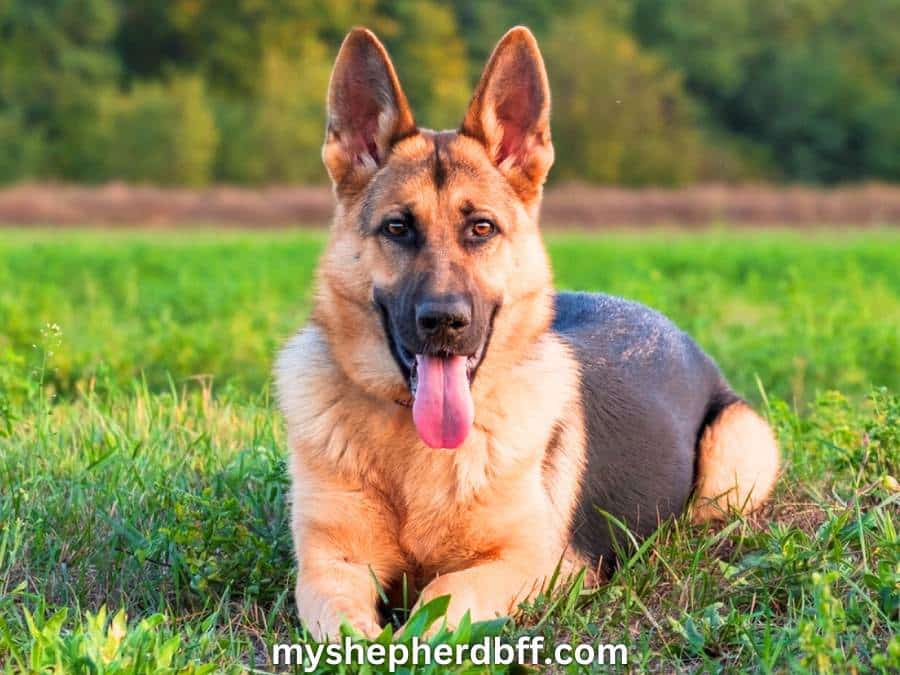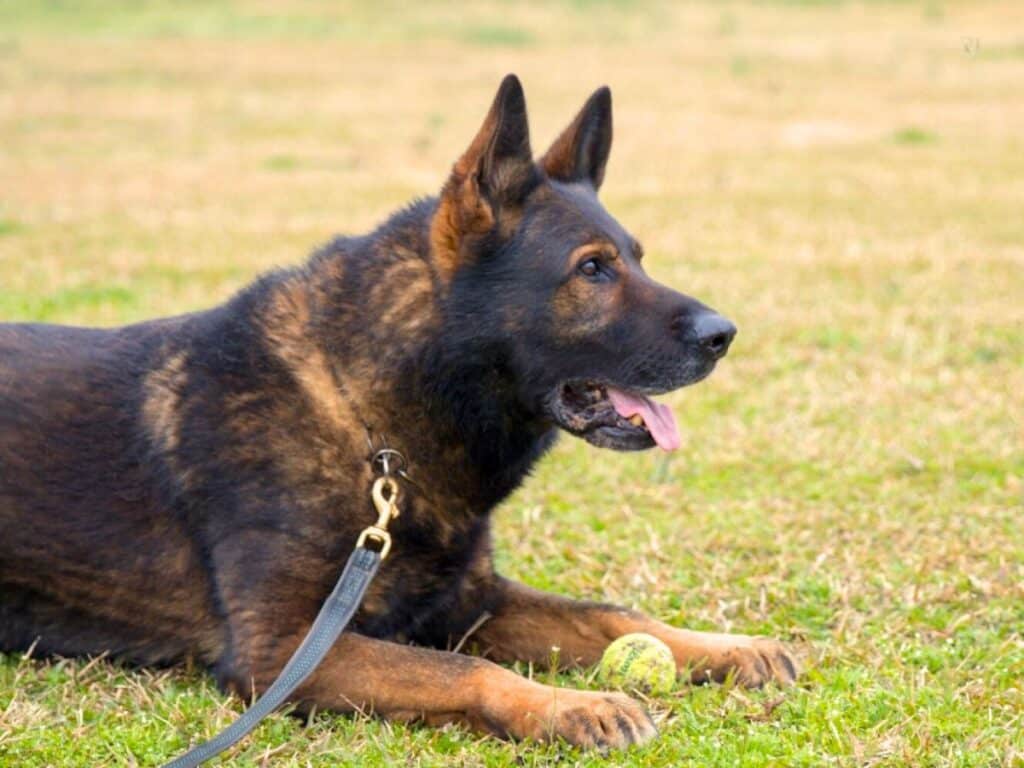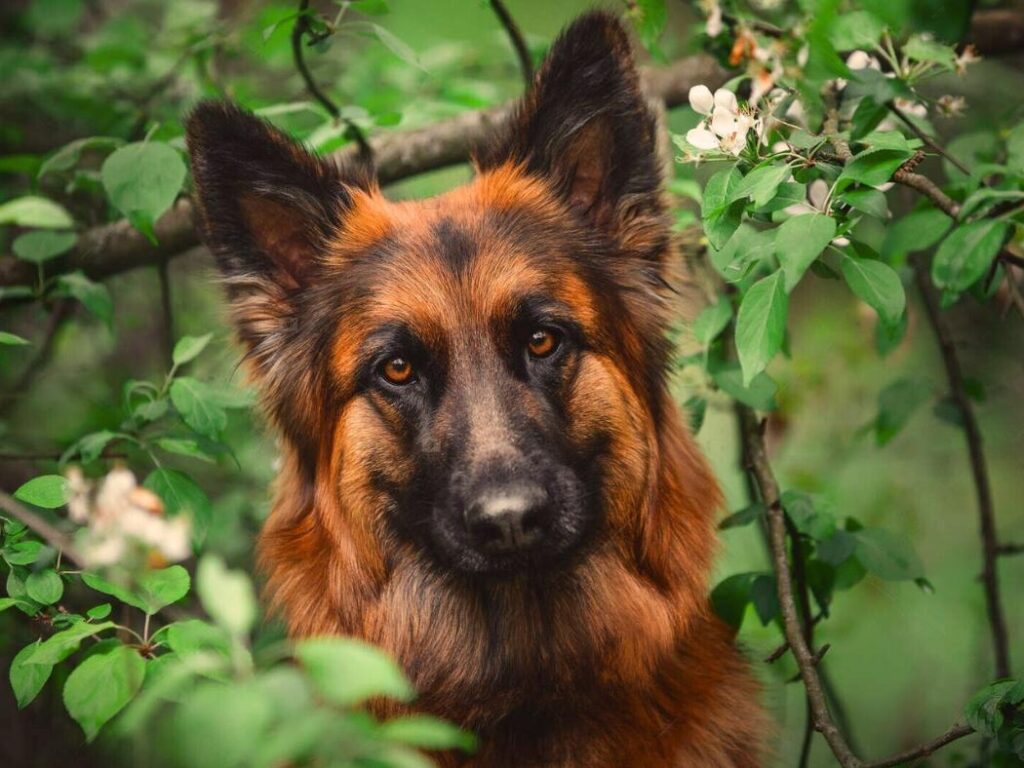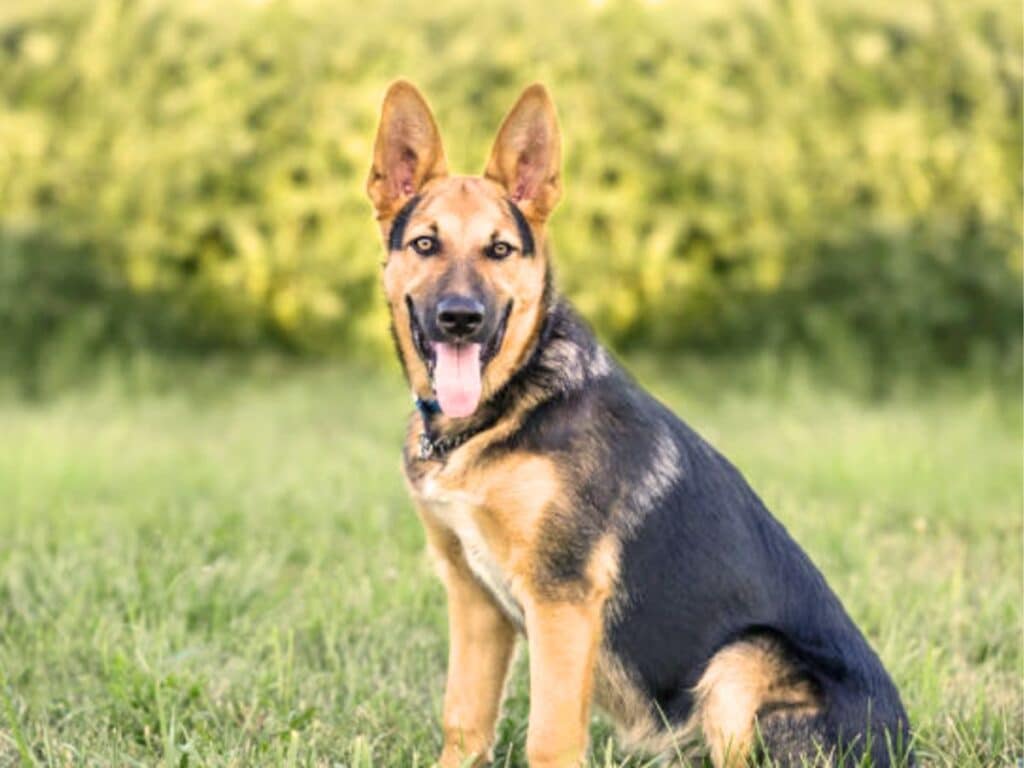The black and tan coloration, synonymous with the German Shepherd breed, emerged as a dominant and desirable trait through selective breeding. This color pattern was not only aesthetically pleasing but also served practical purposes in the field, providing camouflage and a distinct appearance that set these dogs apart from their peers.
This comprehensive guide aims to provide enthusiasts and potential GSD owners with a deep understanding of this specific coloration of German Shepherd, covering their personality traits, and health and care needs, and we will explore the training and activities best suited for their energetic and intelligent nature.
Black and Tan German Shepherds: Overview
Below is a table summarizing the key details of the Black and Tan German Shepherd:
| Attribute | Detail |
|---|---|
| Breed Name | German Shepherd |
| Origin | Germany |
| Size Category | Medium to Large |
| Weight | Males: 65-90 pounds (29-41 kg)Females: 50-70 pounds (23-32 kg) |
| Height | Males: 24-26 inches (60-65 cm)Females: 22-24 inches (55-60 cm) |
| Lifespan | Approximately 9-13 years |
| Coat Type | Double coat: Dense, straight, and harsh outer coat with a softer undercoat |
| Key Temperament Traits | Intelligent, Loyal, Courageous, Highly Trainable, Protective |
| Exercise Needs | High: Requires 1-2 hours of daily physical activity and mental stimulation |
| Health Concerns | Hip and Elbow Dysplasia, Degenerative myelopathy, Gastric Dilatation-Volvulus (Bloat), and Eye disorders |
| Diet | High-quality dog food tailored to the dog’s age, size, and activity level |
| Family suitability | Excellent for families and kids |
| Price | $500-$1500 |

How Did Black & Tan GSDs Get Their Classic Color?
German Shepherd breed’s journey begins in late 19th century Germany, under the guidance of its founding father Max von Stephanitz, a former cavalry captain and a fervent advocate for the development of German herding dogs.
Stephanitz’s vision was clear: to breed a dog that excelled in intelligence, agility, and loyalty. The result was the German Shepherd dog.
The breed’s early roles were varied, from herding livestock to serving as messengers, guard dogs, and search and rescue operatives in World War I.
In the 1920s, the breed made its way to the United States, where its popularity soared, particularly in the role of a Hollywood star, thanks to Rin Tin Tin, a rescued war dog who became a cinematic sensation.
This exposure not only solidified the German Shepherd’s place in popular culture but also highlighted the breed’s remarkable trainability, intelligence, and noble demeanor.
Breeders in the USA, focused on refining the black & tan coat color for its practical benefits and symbolic status, ensuring that the black and tan coloration remained a hallmark of the breed.
This meticulous attention to breeding has preserved the distinctive appearance and capabilities of the black and tan German Shepherd, making it a beloved icon in the canine world.
Presently, Black & Tan GSDs account for approximately 63% of all German Shepherds registered with the American Kennel Club (AKC).
Click here to explore my gallery of pictures of black and tan German Shepherds & puppies!

Physical Characteristics
In this section, let’s examine the key features that define the black and tan German Shepherd, from its coat pattern to its overall physique.
Coat and Coloration
Central to the black and tan German Shepherd’s appearance is its luxurious double coat, designed for protection and adaptability in various climates.
The topcoat is dense, straight, and harsh to the touch, lying close to the body, while the undercoat is softer and provides insulation.
The hallmark black and tan coloration features rich, black markings over a tan or cream base.
These markings are typically found on the back, including a distinctive “saddle” pattern, and the face, where a black “mask” accentuates the dog’s keen eyes and intelligent expression.
Size and Structure
German Shepherds are medium to large-sized dogs, with males standing 24 to 26 inches tall at the shoulder and females slightly smaller at 22 to 24 inches.
The ideal weight ranges from 65 to 90 pounds for males and 50 to 70 pounds for females, though these figures can vary based on diet and exercise.
The breed exhibits a unique silhouette, with a slight slope from the back to a powerful hindquarters, allowing for their famous fluid, trotting gait.
Head and Facial Features
The head of the these dogs is proportional to its body, with a broad skull, a straight, square-cut muzzle, and medium-sized, almond-shaped eyes that convey an intelligent and alert expression.
The ears are large and stand erect, open at the front and parallel, but they may be pulled back during movement or when relaxed.
Temperament and Behavior
It’s important to note that the temperament of a German Shepherd, known for its versatility as a companion, protector, and worker, is not influenced by its coat color.
Therefore, the Black & Tan German Shepherds possess the same capacity for obedience, trainability, and affection towards their families.
The temperament of the black and tan German Shepherd is a product of its breeding, reflecting the qualities that have been meticulously selected for over generations.
- Intelligent and quick learners: Known for their high intelligence, Black & Tan GSDs excel in problem-solving and can learn commands and tasks quickly.
- Loyal and protective: They form strong bonds with their families and are known to be extremely loyal. Their protective nature makes them excellent guard dogs, always alert and ready to defend their loved ones.
- Highly trainable: Their eagerness to please and intelligence make them highly trainable. They respond well to positive reinforcement and consistent training routines.
- Active and energetic: These dogs have high energy levels and require regular exercise to keep them physically and mentally stimulated.
- Social and affectionate: With proper socialization, they are friendly and affectionate towards their family members, including children. They thrive on interaction and being part of family activities.
- Alert and watchful: They are naturally vigilant and have a keen sense of awareness about their environment, making them excellent watchdogs.
- Adaptable: While they do best with space to roam and exercise, they can adapt to various living situations as long as their physical and mental stimulation needs are met.
- Strong work ethic: Originally bred for herding and work, they possess a strong work ethic and often excel in roles such as service dogs, police dogs, and in various canine sports.
Remember, while these traits are commonly observed in Black & Tan German Shepherds, individual personalities may vary. Proper training, socialization, and care are essential to bring out the best in any dog.

Health and Care
Diet and Nutrition
A balanced diet is crucial for maintaining the health and vitality of a German Shepherd.
High-quality dog food, appropriate to the dog’s age (puppy, adult, senior), size, and activity level, will provide the necessary nutrients.
Given their active nature, these dogs may benefit from diets formulated for active breeds, containing a proper balance of protein, fat, carbohydrates, and essential vitamins and minerals.
Portion control and regular meal times help prevent obesity, a growing concern that can exacerbate joint issues and other health problems.
Exercise and Physical Activity
Their high energy and intelligence demand regular physical exercise and mental stimulation.
Daily activities such as walking, running, hiking, and playing fetch can help keep these dogs physically fit and mentally sharp.
Agility training, obedience trials, and herding activities can also provide excellent outlets for their energy and instincts.
Preventative Care
Preventive health measures are vital in ensuring the well-being of any pet, and these GSDs are no exception.
Regular veterinary check-ups, vaccinations, and parasite control are fundamental components of preventative care.
Additionally, dental hygiene, through brushing and professional cleanings, can prevent gum disease and other health issues.

Training and Activities
Training and engaging in a variety of activities are crucial for the well-being of these dogs. Given their intelligence, energy, and work ethic, these dogs thrive in environments where they can learn, play, and work.
Training Tips
- Start early: Begin training and socialization as soon as you bring your German Shepherd puppy home. Early training lays the foundation for a well-behaved adult dog.
- Use positive reinforcement: Reward-based training methods, including treats, praise, and play, encourage your dog to learn by making training sessions enjoyable and rewarding.
- Be consistent: Consistent commands, rules, and routines help your dog understand what is expected of them, leading to faster learning and fewer behavioral issues.
- Set clear boundaries: Teach your dog the rules of the house from the start. Clear boundaries make it easier for your dog to understand what is allowed and what isn’t.
- Provide mental stimulation: German Shepherds are highly intelligent and require mental stimulation to stay happy. Use puzzle toys, obedience training, and trick training to keep their minds active.
- Socialization: Expose your dog to different people, animals, environments, and situations to develop a well-rounded, confident, and sociable pet.
- Incorporate variety: Keep training sessions short, fun, and varied to maintain your dog’s interest. Long, repetitive sessions can lead to boredom and disengagement.
- Seek professional help if needed: If you encounter behavioral issues or challenges in training, consider enlisting the help of a professional dog trainer or behaviorist.
By following these tips, you can foster a strong, positive relationship with your GSD, ensuring they grow up to be well-behaved and well-adjusted companions.
Suitable Activities
German Shepherds thrive on physical activity and mental stimulation. Here are some suitable activities to keep your German Shepherd engaged and healthy:
- Daily walks: Long walks or hikes are great for physical exercise and mental stimulation. It’s also an excellent opportunity for bonding.
- Fetch and frisbee: Playing fetch or frisbee in a spacious area can help burn off energy and improve agility.
- Obedience training: Regular obedience training sessions not only reinforce good behavior but also provide mental stimulation.
- Agility training: Agility courses challenge your dog physically and mentally, enhancing their agility, obedience, and problem-solving skills.
- Tracking exercises: Utilize their natural tracking abilities in fun, scent-based games or formal tracking activities.
- Swimming: Many German Shepherds enjoy swimming, which is an excellent low-impact exercise for dogs.
- Tug-of-War: A controlled game of tug-of-war can be a fun way to exercise and strengthen the bond with your dog, just ensure it’s played with clear rules.
- Puzzle toys: Toys that challenge them to think and solve problems to receive a treat are great for mental stimulation.
- Socialization outings: Visiting dog-friendly parks, stores, or events helps with socialization and provides new sights and smells to explore.
Remember, each dog has its own preferences and abilities, so it’s important to find activities that your German Shepherd enjoys and is physically capable of doing.

Black and Tan German Shepherd Price
The price of a Black & Tan German Shepherd can vary widely based on several factors such as pedigree, breeder reputation, location, and whether the dog is being purchased as a pet, for work, or for show.
- Pet Quality: Dogs that are sold as pets (without breeding rights and not for show) can range from approximately $500 to $1,500.
- Working or Show Quality: German Shepherds that are bred for specific work roles (like police or service dogs) or for conformation shows can have prices ranging from $1,500 to $3,000 or more.
The prices and considerations that I have mentioned are meant to provide a broad overview and may change over time or vary by location. Always do your research and consider both the initial costs and long-term care expenses when thinking about bringing a German Shepherd into your home.
Choosing a Black and Tan German Shepherd Puppy
Deciding to welcome a black and tan German Shepherd into your life is a commitment that comes with the responsibility of ensuring you’re prepared for the journey ahead.
Whether through purchase or adoption, selecting this breed requires careful consideration of several factors to ensure the well-being of the dog and a harmonious match with your lifestyle.
Finding a Reputable Breeder
- Research: Start by researching breeders who specialize in German Shepherds, particularly those with a focus on the black and tan coloration. Look for breeders who prioritize health, temperament, and adherence to breed standards.
- Health Clearances: A reputable breeder should provide health clearances for both parents, proving they’ve been tested for common genetic diseases associated with the breed.
- Visit the Breeder: If possible, visit the breeder’s facility to observe the conditions in which the puppies are raised. This visit can offer insights into the socialization and care the puppies receive early on.
For more guidance on this topic, you can refer to my article Buying a German Shepherd Puppy In 6 Simple Steps.
Considerations for Adoption
- Shelters and Rescue Groups: Many German Shepherds end up in shelters or with rescue groups. Adopting from these sources can offer a loving dog a second chance at a happy life.
- Assessment: When adopting, assess the dog’s temperament and health with the help of shelter staff or a veterinarian. Be prepared for the possibility of addressing behavioral issues with patience and training.
To learn more about GSD adoption, you can check out my article Rescuing a German Shepherd.
Welcoming Your Dog Home
Bringing a pup into your home requires preparation, including setting up a safe space for your new pet, investing in quality food and supplies, and planning for regular exercise and training sessions.
Remember, the transition period is crucial for building trust and establishing routines, setting the foundation for a lasting and rewarding companionship.
RELATED: How to Prepare Your Home For a New German Shepherd

Black & Tan vs Other Coat Colors
German Shepherds come in a variety of colors and patterns such as liver, silver, white, black, sable, red sable, blue, and a few more rare colors.
To learn more about the different GSD colors, you can check out my article German Shepherd Colors.
Black and Red vs Black and Tan German Shepherd
The Black and Tan variety features a base of tan fur that ranges from a light, almost cream color, to a deep, rich gold, set against striking black markings. These markings typically cover the back, face, and ears, giving them a classic, timeless look.
On the other hand, the Black and Red German Shepherd boasts a more vibrant contrast, with the red portions of their coat ranging from a dark, rich mahogany to a bright, fiery hue.
Bicolor vs Black and Tan German Shepherd
Black and Tan German Shepherd is characterized by its iconic, contrasting coat that prominently features tan fur with black markings over the saddle, face, and tail.
In contrast, the Bi-Color German Shepherd is predominantly black, with tan or lighter markings that are much more subdued and usually only appear on the legs, feet, and perhaps a hint beneath the tail.
Bi-Color German Shepherds can sometimes be mistaken for solid black from a distance, as their black fur covers most of their body, including the face, back, and sides.
Final Remarks
For prospective owners, understanding the responsibilities and joys that come with owning a black and tan German Shepherd is the first step toward a rewarding relationship. These dogs require commitment in terms of care, training, and affection, but the return is immeasurable.
Their loyalty, courage, and capacity for love reflect the best qualities of the canine spirit, making them more than pets—they are true partners in life’s adventures.




